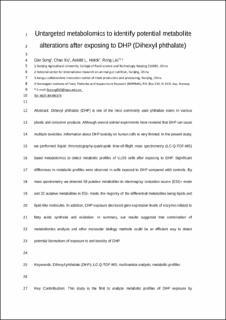| dc.description.abstract | Dihexyl phthalate (DHP) is one of the most commonly used phthalate esters in various plastic and consumer products. Human are inevitably exposed to DHPs. Although several animal and human experiments have revealed that DHP can cause multiple toxicities, few studies have previously assessed the effects of DHP exposure by liquid chromatography mass spectrometry (LC-MS) analysis combine with molecular biology methods on human cells. Therefore, the purpose of our study was to investigate the effect of DHP on human cell metabolism by systems biology methods. In this study, U2OS cancer cells were treated with 10 μM DHP for metabolomics analysis and apoptosis analysis at indicate time. Metabolomic study of the metabolic changes caused by DHP in U2OS cells was performed for the first time using integrative liquid chromatography coupled with quadrupole time-of-flight mass spectrometry (LC-Q-TOF-MS). To investigate the possible reason of fatty acids level altered by DHP, we measured some key fatty acid synthesis and oxidation-related enzyme expression levels by quantitative real-time PCR (Q-PCR). Apoptotic cells were analyzed by flow cytometry and apoptosis-related gene expressions were measured by Q-PCR. 20,70-Dichlorofluorescein diacetate (DCFH-DA) staining was used to evaluate ROS content. Partial least squares-discriminate analysis (PLS-DA) clearly showed that significant differences in metabolic profiles were observed in U2OS cells exposed to DHP compared with controls. A total of 58 putative metabolites in electrospray ionization source (ESI) + mode and 32 putative metabolites in ESI-mode were detected, the majority of the differential metabolites being lipids and lipid-like molecules. Among them, the altered fatty acids level corresponded to expression levels of genes encoding enzymes related to fatty acids synthesis and oxidation. Moreover, DHP induced reactive oxygen species (ROS) accumulation, promoted cell apoptosis and inflammation, and resulted in a significant increase in apoptosis and inflammationrelated gene expression levels compared with controls. In summary, our results suggested that metabolomics combined with molecular bioanalysis methods could be an efficient tool to assess toxic effects, which contribute to explore the possible cytotoxicity mechanisms of DHP, and provide a basis for further research. | |
